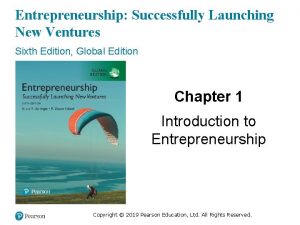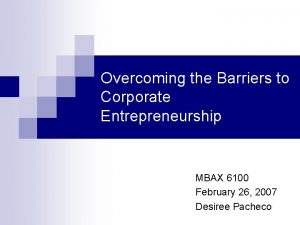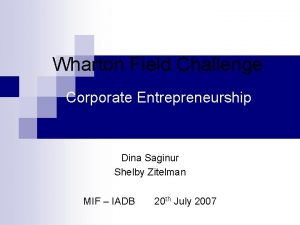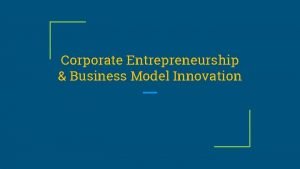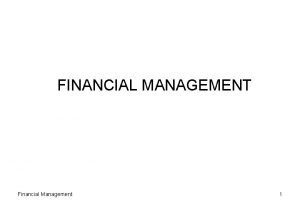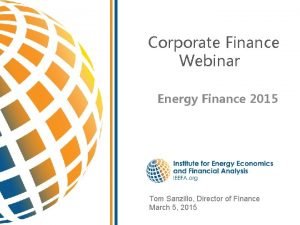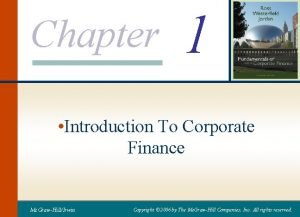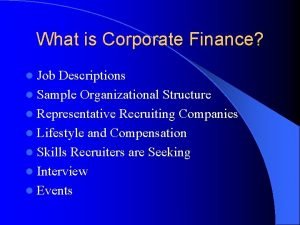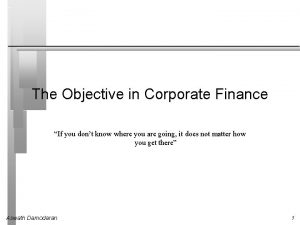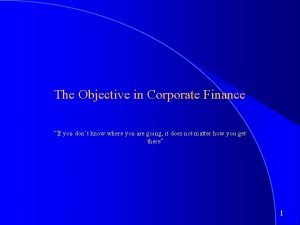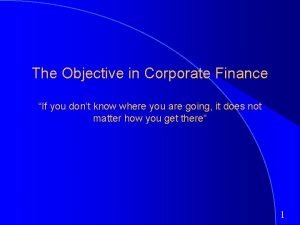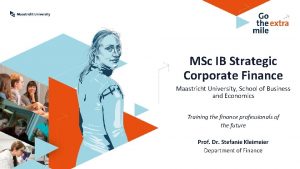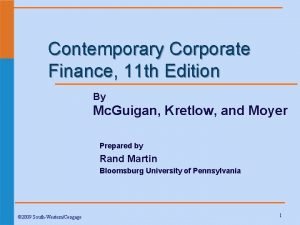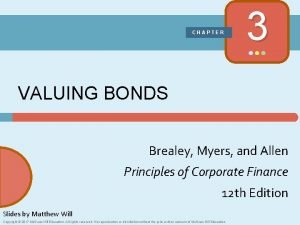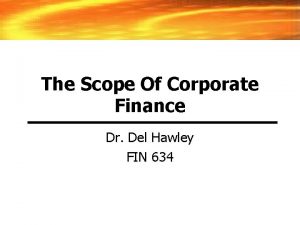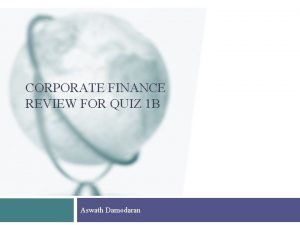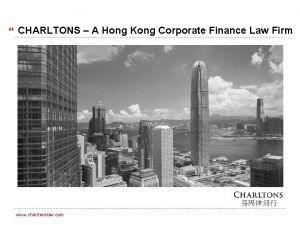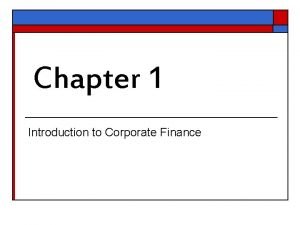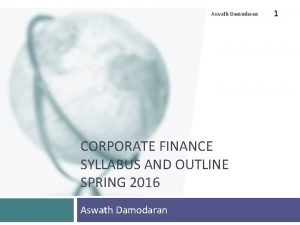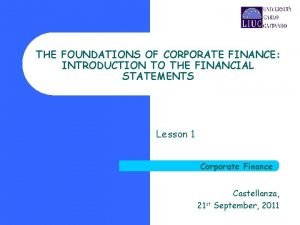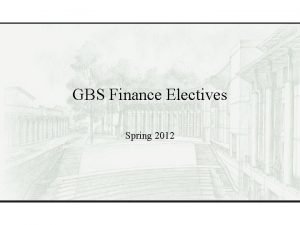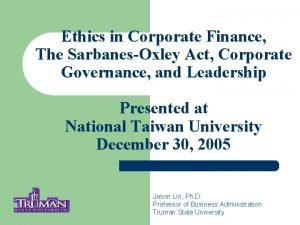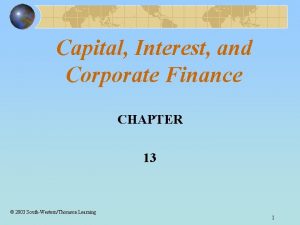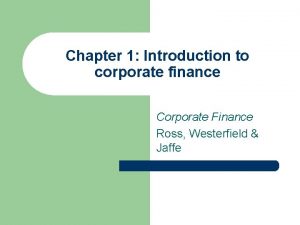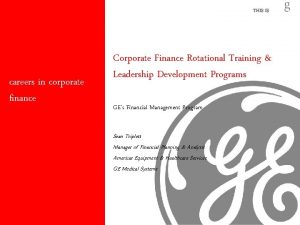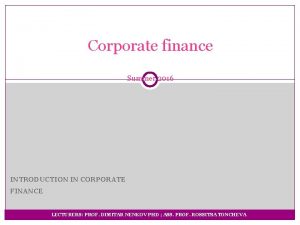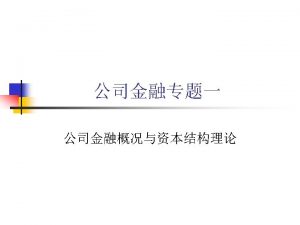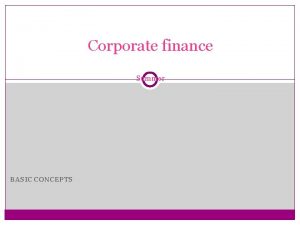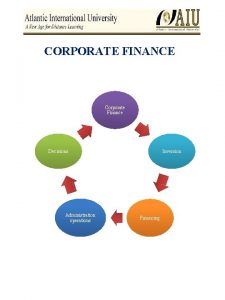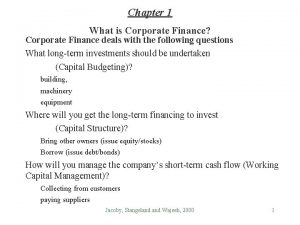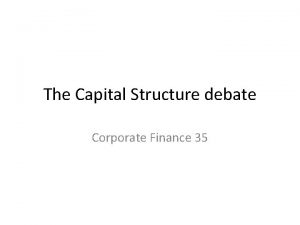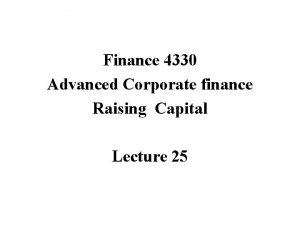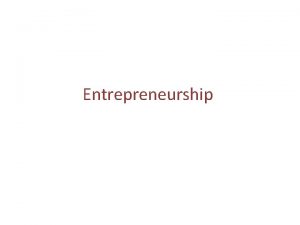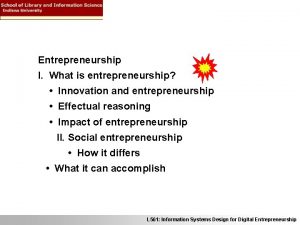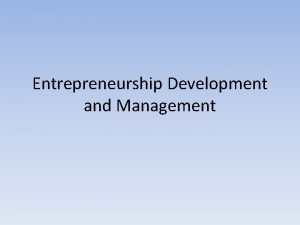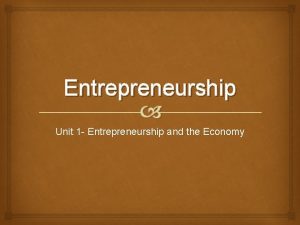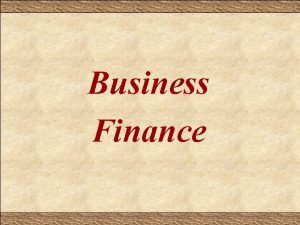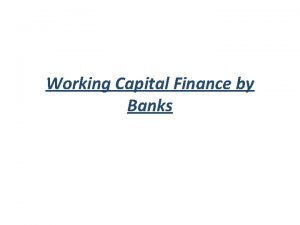13 Capital Interest Entrepreneurship and Corporate Finance 2019





































- Slides: 37

13 Capital, Interest, Entrepreneurship, and Corporate Finance © 2019 Cengage. All Rights Reserved.

LEARNING OUTCOMES 1. Derive a firm’s demand curve for investment, and determine its marginal cost of investing 2. Explain what determines the interest rate for loanable funds 3. Describe four reasons why interest rates differ across markets 4. Demonstrate how to convert future dollars into their present value 5. Summarize how entrepreneurs drive the economy forward 6. Distinguish between stocks and bonds, and explain which involves more risk and why © 2019 Cengage. All Rights Reserved. MICRO 6 | CH 13 2

Production, Saving, and Time • Production • Cannot occur without prior saving • Requires saving as production takes time �Goods and services are not available from current production • More capital in an economy means more goods can be produced in the future © 2019 Cengage. All Rights Reserved. MICRO 6 | CH 13 3

Consumption, Saving, and Time • Positive rate of time preference • Consumers value present consumption more than future consumption • People must be rewarded to postpone consumption • Interest rate • Interest per year as a percentage of the amount saved or borrowed • Reward for postponing consumption © 2019 Cengage. All Rights Reserved. MICRO 6 | CH 13 4

Consumption, Saving, and Time (continued) • Consumers have a positive rate of time preference due to: �Impatience �Uncertainty © 2019 Cengage. All Rights Reserved. MICRO 6 | CH 13 5

Optimal Investment • In market economies characterized by specialization and exchange, producers can: • Purchase capital • Borrow funds • Firms buy new capital goods if they expect this investment to yield a higher return than other possible uses of their funds © 2019 Cengage. All Rights Reserved. MICRO 6 | CH 13 6

Optimal Investment (continued 1) • Expected rate of return on capital • Expected annual earnings divided by capital’s purchase price • Market interest rate • Opportunity cost of investing • Optimal investment • Expected rate of return = market interest rate © 2019 Cengage. All Rights Reserved. MICRO 6 | CH 13 7

Exhibit 1 Expected Rate of Return on Golf Carts and the Opportunity Cost of Funds An individual firm invests in any project with an expected rate of return that exceeds the market interest rate. At an interest rate of 8 percent, Hacker Haven invests $15, 000 in three golf carts. © 2019 Cengage. All Rights Reserved. MICRO 6 | CH 13 8

ptimal Investment (continued 2) • Investment demand curve for individu industries • Downward-sloping �More is invested when the opportunity cost of borrowing is lower • Investment demand curve for the ent economy M • Downward-sloping �More is invested when the opportunity cost of borrowing is lower © 2019 Cengage. All Rights Reserved.

Optimal Investment (continued 3) • Intellectual property • An intangible asset created by human knowledge and ideas © 2019 Cengage. All Rights Reserved. MICRO 6 | CH 13 10

e Market for Loanable Funds • Demanders of loans (borrow) M • Entrepreneurs �Start firms �Invest in physical and intellectual capit �Increase investment until expected rat return on the marginal investment equ market interest rate • Households �Value present consumption more than future consumption �Invest in human capital © 2019 Cengage. All Rights Reserved.

The Market for Loanable Funds (continued 1) • Demand for loanable funds • Negative relationship between the market interest rate and the quantity of loans demanded, other things constant • Reflects a declining rate of return on investment • Other factors assumed to be constant �Prices of other resources, technology �Expected rate of inflation, tax laws �Customs and conventions of the market © 2019 Cengage. All Rights Reserved. MICRO 6 | CH 13 12

The Market for Loanable Funds (continued 2) • Supply of loanable funds • Positive relationship between the market interest rate and the quantity of savings supplied • Interest rate = reward for saving • Suppliers of loanable funds • Banks = financial intermediaries © 2019 Cengage. All Rights Reserved. MICRO 6 | CH 13 13

The Market for Loanable Funds (continued 3) • Loanable funds market • Savers (suppliers of loanable funds) and borrowers (demanders of loanable funds) come together to determine the: �Market interest rate �Quantity of loanable funds © 2019 Cengage. All Rights Reserved. MICRO 6 | CH 13 14

Exhibit 2 Market for Loanable Funds Because of the declining expected rate of return on capital, the quantity of loanable funds demanded is inversely related to the interest rate. The market rate of interest, 8 percent, is found where the demand curve for loanable funds intersects the supply curve of loanable funds. An increase in the demand for loanable funds from D to D’ raises the market interest rate from 8 percent to 9 percent and increases the equilibrium quantity of loanable funds from $1. 0 trillion to $1. 1 trillion. © 2019 Cengage. All Rights Reserved. MICRO 6 | CH 13 15

Why Interest Rates Differ • Prime rate • Interest rate lenders charge their most trustworthy business borrowers • Collateral • Asset pledged by the borrower that can be sold to pay off the loan in the event the borrower defaults © 2019 Cengage. All Rights Reserved. MICRO 6 | CH 13 16

hy Interest Rates Differ (continued 1) • Risk • Banks ask for collaterals to reduce risk • More valuable the collateral, lower the interest rate • Duration of the loan M • Loan repayment in the future is uncertain • Longer the duration of the loan, higher th interest rate © 2019 Cengage. All Rights Reserved.

Why Interest Rates Differ (continued 2) • Term structure of interest rates • The relationship between the duration of a loan and the interest rate charged; typically interest rates increase with the duration of the loan, because longer loans are considered more risky • Administration costs • Decrease as the size of the loan increases • Interest rates decrease as administration costs decrease • Tax treatment © 2019 Cengage. All Rights Reserved. MICRO 6 | CH 13 18

Exhibit 3 Interest Rates Charged for Different Types of Loans Interest rates are higher for riskier loans. Rates for home mortgages and new cars are relatively low because these loans are backed up by the home or car as collateral. Personal loans and credit card balances face the highest rates, because these loans are riskier —that is, the likelihood borrowers fail to repay the loans is greater and the borrower offers no collateral. © 2019 Cengage. All Rights Reserved. MICRO 6 | CH 13 19

Present Value and Discounting • Present value • Current value of payment(s) to be received in the future • Discounting • Converting future dollar amounts into present value © 2019 Cengage. All Rights Reserved. MICRO 6 | CH 13 20

esent Value and Discounting (continued • Present value of payment one year hence M • Amount received one year from now divi by (1 + interest rate) • Higher the interest rate, lower its presen value © 2019 Cengage. All Rights Reserved.

Present Value and Discounting (continued 2) • Present value (PV) for payments (M) in later years (t) • Smaller for higher t © 2019 Cengage. All Rights Reserved. MICRO 6 | CH 13 22

Present Value and Discounting (continued 3) • Present value of an income stream • Receive $100 next year • And $150 year after next • i = 5% © 2019 Cengage. All Rights Reserved. MICRO 6 | CH 13 23

Present Value and Discounting (continued 4) • Annuity • A given sum of money received each year for a specified number of years • Present value of an annuity • Perpetuity—if the income stream continues indefinitely �Present value of receiving M dollars each year forever © 2019 Cengage. All Rights Reserved. MICRO 6 | CH 13 24

Entrepreneurship • Entrepreneur • • Comes up with an idea Turns that idea into a marketable product Accepts the risk of success or failure Claims any resulting profit or loss (residual claimant) © 2019 Cengage. All Rights Reserved. MICRO 6 | CH 13 25

Entrepreneurship (continued 1) • Entrepreneur • Has the authority to hire and fire managers • Drives the economy forward �New products �Improvement in existing products �New production methods �New ways of doing business © 2019 Cengage. All Rights Reserved. MICRO 6 | CH 13 26

Entrepreneurship (continued 2) • Who are not entrepreneurs? • Corporate inventors • Managers • Stockholders © 2019 Cengage. All Rights Reserved. MICRO 6 | CH 13 27

Corporate Finance • Corporations • Legal entities that are owned by stockholders • Own property • Earn profit • Sue or get sued • Incur debt © 2019 Cengage. All Rights Reserved. MICRO 6 | CH 13 28

Corporate Stock • Corporations fund investment • Issue and sell stock • Retain some of their profits • Borrow • Initial public offering (IPO) • Initial sale of corporate stock to the public • Corporate stock • Certificate reflecting part ownership of a corporation © 2019 Cengage. All Rights Reserved. MICRO 6 | CH 13 29

Corporate Stock (continued) • Corporations pay • Corporate income taxes on any profit • Dividends to shareholders • Dividends • After-tax corporate profit paid to stockholders rather than retained by the firm and reinvested © 2019 Cengage. All Rights Reserved. MICRO 6 | CH 13 30

Retained Earnings • Retained earnings • After-tax corporate profit reinvested in the firm rather than paid to stockholders as dividends • Help the firm grow © 2019 Cengage. All Rights Reserved. MICRO 6 | CH 13 31

Corporate Bonds • Corporations borrow • Bank loan • Issue and sell bonds • Bond • Certificate reflecting a firm’s promise �To pay the lender periodic interest �To repay the borrowed sum of money on the designated maturity date • Less risky than stocks © 2019 Cengage. All Rights Reserved. MICRO 6 | CH 13 32

Securities Exchange • Securities market • Exchange of stocks and bonds • Secondary market for securities �Enhance liquidity • Hedge funds follow complex strategies to invest for institutions • Determine the current value of a corporation • Allocates funds more readily to successful firms than to firms in financial difficulty © 2019 Cengage. All Rights Reserved. MICRO 6 | CH 13 33

Securities Exchange (continued) • Crowdfunding • Raising money from many people through an online platform © 2019 Cengage. All Rights Reserved. MICRO 6 | CH 13 34

KEY TERMS • Positive rate of time preference • Interest rate • Expected rate of return on capital • Intellectual property • Demand for loanable funds • Supply of loanable funds • Loanable funds market • Prime rate • Collateral • Term structure of interest rates • Present value • Discounting • Annuity • Initial public offering • Corporate stock • Dividends • Retained earnings • Bond • Crowdfunding © 2019 Cengage. All Rights Reserved. MICRO 5 • HIST 4| |CH 13 CH 6 • 35

SUMMARY • Market interest rate is the opportunity cost and the marginal cost of investing in capital • Intersection of the demand supply curves for loanable funds determines the market interest rate • Interest rates differ because of risk, duration of the loan, administration costs, and tax treatment • Present value of a future payment is the future payment divided by 1 plus the prevailing interest rate • Entrepreneur comes up with an idea, turns that idea into a marketable product, accepts the risk of success or failure, and claims any resulting profit or loss • Stocks are riskier than bonds © 2019 Cengage. All Rights Reserved. • HIST 4 | CH 6 • 36

© 2019 Cengage. All Rights Reserved. MICRO 6 | CH 13 37
 Causes for interest in corporate entrepreneurship
Causes for interest in corporate entrepreneurship Objectives of corporate finance
Objectives of corporate finance Introduction to entrepreneurship module pdf
Introduction to entrepreneurship module pdf What is real interest rate and nominal interest rate
What is real interest rate and nominal interest rate Simple and compound interest
Simple and compound interest Types of corporate entrepreneurship
Types of corporate entrepreneurship Types of corporate entrepreneurship
Types of corporate entrepreneurship Barriers to corporate entrepreneurship
Barriers to corporate entrepreneurship Wharton field challenge
Wharton field challenge Four models of corporate entrepreneurship
Four models of corporate entrepreneurship Effective interest rate formula
Effective interest rate formula Fundamentals of corporate finance chapter 6 solutions
Fundamentals of corporate finance chapter 6 solutions Financial management theory
Financial management theory Tom sanzillo
Tom sanzillo Corporate finance vs investment banking
Corporate finance vs investment banking Chapter 1 introduction to corporate finance
Chapter 1 introduction to corporate finance Corporate finance job scope
Corporate finance job scope Objective of corporate finance
Objective of corporate finance Objective of corporate finance
Objective of corporate finance Objective of corporate finance
Objective of corporate finance Strategic corporate finance maastricht
Strategic corporate finance maastricht Fundamentals of corporate management
Fundamentals of corporate management Contemporary corporate finance
Contemporary corporate finance Principles of corporate finance chapter 3 solutions
Principles of corporate finance chapter 3 solutions Scope of corporate finance
Scope of corporate finance Objective of corporate governance
Objective of corporate governance Fundamentals of corporate finance, third canadian edition
Fundamentals of corporate finance, third canadian edition Corporate finance quiz
Corporate finance quiz Charlton law firm
Charlton law firm Corporate finance tenth edition
Corporate finance tenth edition Chapter 1 introduction to corporate finance
Chapter 1 introduction to corporate finance Corporate finance syllabus
Corporate finance syllabus Foundations of corporate finance
Foundations of corporate finance Gbs corporate finance
Gbs corporate finance Fundamentals of corporate finance third canadian edition
Fundamentals of corporate finance third canadian edition Fundamentals of corporate finance fifth edition
Fundamentals of corporate finance fifth edition Ethics in corporate finance
Ethics in corporate finance Corporate finance overview
Corporate finance overview





